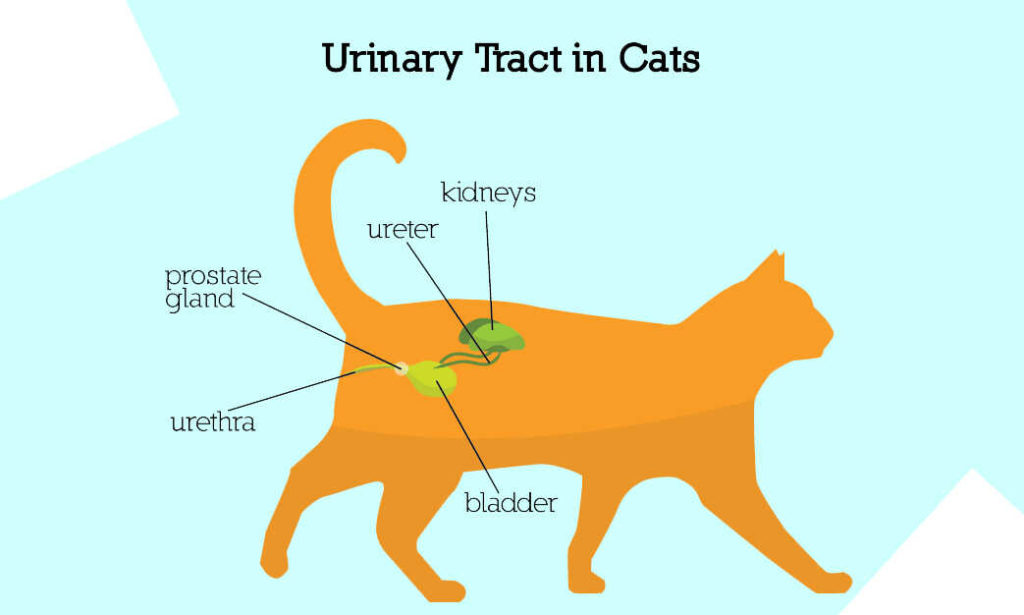Urinary tract infections are common in cats and they are often easy to diagnose and treat. A modified diet and proper food can help to solve the problem of cats with urinary tract issues.
Remember, some foods not only promote health but also prevent the formation of mineralized stones or crystals which can annoy your cat’s bladder.
Cat foods that are marketed particularly toward urinary tract health are greatly formulated to melt excess minerals.
As well as introduce methionine, an amino acid that prevents bacteria from sticking to urinary tract cells and necessary prebiotics, probiotics, enzymes, antioxidants, and more.
What is Cat Urinary Tract Issue?
The cat urinary tract is a system that starts with the kidneys and goes all the way down to the urethra.
The kidneys are responsible for filtering out waste from the blood, and the urethra is the tube that urine travels through when it leaves the body.
Urinary tract issues can occur when there is a blockage in the urinary tract, an infection, or a problem with the kidneys. This problem is also called FLUTD (Feline Lower Urinary Tract Disease).

Symptoms of Urinary Tract Infections in Cats
Cats, known for their mysterious and independent nature, are also prone to various health issues, including urinary tract infections (UTIs). These infections can cause discomfort and distress for your feline friend.
Recognizing the signs and seeking prompt care.
Pain or Discomfort When Urinating
Cats with urinary tract infections often experience pain or discomfort during urination. This can manifest as vocalization, excessive licking of the genital area, or even distress while using the litter box.
Owners might notice their cats straining or taking longer than usual to urinate. These signs indicate that something is amiss and require immediate attention.
Not Urinating at All
One alarming symptom of urinary tract issues is the inability to urinate altogether. This condition, known as “urinary obstruction,” is more common in male cats due to their narrower urethra.
Obstruction can lead to a life-threatening situation, as the accumulated toxins in the body are unable to be eliminated. If your cat is attempting to urinate but no urine is produced, it’s a critical emergency.
Reduced Amounts of Urine
A noticeable decrease in the volume of urine produced during each urination can be indicative of a urinary tract problem.
Cats with UTIs may urinate more frequently but only pass small amounts of urine each time.
This is often accompanied by the sensation of urgency and discomfort, as they try to relieve themselves more often.
Discolored Urine
The color of your cat’s urine can provide valuable information about their health. If you observe a change in the color of the urine, it could be a sign of an underlying issue.
Urine that appears darker than usual might suggest dehydration, while unusually light or clear urine might indicate excessive water consumption.
Blood in the Urine or Pinkish-Colored Urine
One of the most concerning symptoms of urinary tract infections is the presence of blood in the urine, often giving it a pinkish hue.
This condition, known as hematuria, can be indicative of inflammation or irritation in the urinary tract. Hematuria can cause significant concern for cat owners and should not be ignored.
Urinating Outside of the Litter Box
One of the telltale signs that your cat might be dealing with a urinary tract issue is a sudden change in their litter box behavior.
Cats are inherently clean animals and usually use the litter box consistently. However, if your cat starts urinating outside of the litter box, it can indicate an underlying problem.
This behavior can stem from discomfort or pain while using the litter box due to a urinary issue.
Keep an eye out for any puddles or damp spots around your home, as they could signal a potential problem.
Straining to Urinate
Observing your cat straining or spending an unusually long time in the litter box without producing much urine can be a clear indicator of a urinary tract issue.
This behavior often accompanies discomfort and suggests that your cat might be experiencing difficulty while urinating.
Straining can be painful for your feline friend and may indicate an obstruction or inflammation in the urinary tract.
If you notice this symptom, it’s important to take action promptly to alleviate your cat’s discomfort.
Signs of Difficulty
Cats experiencing urinary tract problems may exhibit signs of general unease or discomfort. They might become more restless, vocalize more than usual, or exhibit signs of anxiety.
Some cats might even excessively lick their genital area in an attempt to find relief from the discomfort they’re feeling.
It’s crucial to pay attention to any changes in your cat’s behavior, as they can offer valuable clues about their health.
RELATED: How Often Do Cats Poop and Pee
5 Homemade Cat Food Recipes for Urinary Tract Health
Caring for a cat with urinary tract issues requires special attention to their diet. Homemade cat food can provide a solution tailored to their needs.
Chicken and Pumpkin Delight
Ingredients:
- Cooked chicken breast (shredded): 1/4 cup
- Cooked and mashed pumpkin: 2 tablespoons
- Cooked and mashed carrots: 1 tablespoon
- Cooked white rice: 1 tablespoon
Instructions:
- Combine the shredded chicken, mashed pumpkin, carrots, and white rice in a bowl.
- Mix the ingredients well to create a balanced mixture.
- Serve this nutritious blend to your cat. The chicken provides lean protein, while pumpkin and carrots offer dietary fiber, aiding urinary health.
Salmon and Sweet Potato Medley
Ingredients:
- Cooked salmon (flaked): 1/4 cup
- Cooked and mashed sweet potato: 2 tablespoons
- Cooked green peas: 1 tablespoon
- Boiled and chopped spinach: 1 teaspoon
Instructions:
- Gently mix the flaked salmon, mashed sweet potato, green peas, and chopped spinach.
- Ensure the ingredients are evenly distributed to create a well-balanced meal.
- This recipe is rich in omega-3 fatty acids from salmon, aiding in reducing inflammation within the urinary tract.
Turkey and Brown Rice Bowl
Ingredients:
- Cooked ground turkey: 1/4 cup
- Cooked and boiled brown rice: 2 tablespoons
- Cooked and finely chopped zucchini: 1 tablespoon
- Low-sodium chicken broth: 1 teaspoon
Instructions:
- Blend the ground turkey, boiled brown rice, chopped zucchini, and a splash of low-sodium chicken broth.
- Mix well to create a texture that your cat will enjoy.
- The lean protein from turkey and the fiber from zucchini contribute to urinary tract health in this recipe.
Tuna and Spinach Mix
Ingredients:
- Canned tuna in water (drained): 1/4 cup
- Cooked and chopped spinach: 2 tablespoons
- Cooked and mashed quinoa: 1 tablespoon
- Plain yogurt (unsweetened): 1 teaspoon
Instructions:
- Combine the drained tuna, chopped spinach, mashed quinoa, and plain yogurt.
- Mix thoroughly for a nutritious and palatable meal.
- Tuna provides protein while spinach offers vitamins and minerals that aid urinary tract function.
Beef and Carrot Ensemble
Ingredients:
- Cooked lean ground beef: 1/4 cup
- Cooked and mashed carrots: 2 tablespoons
- Cooked and finely chopped broccoli: 1 tablespoon
- Olive oil: 1/2 teaspoon
Instructions:
- Blend the cooked ground beef, mashed carrots, chopped broccoli, and a touch of olive oil.
- Mix well to create a balanced blend that supports urinary health.
- Lean beef provides protein, while carrots and broccoli add essential nutrients.
Related Post: How to Dispose of Cat Poop in an Apartment
Final Thoughts
Feeding your cat wet food can help them stay hydrated, even if they aren’t drinking from a water bowl very often. If your cat primarily eats dry food, a little bit of wet food may be beneficial for their health.
Most experts believe that fish-flavored foods can increase cat’s likelihood of developing urinary crystals or stones.
Dr. John Morris, DVM is a Doctor of Veterinary Medicine who has seven years of experience in feline medicine, dermatology, and behavior. He also enjoys volunteering at a local NGO that supports literacy programs for children and adults. In his free time, he enjoys fostering kittens, traveling, vegan cooking, hiking, and biking. Learn more about Justin here.


